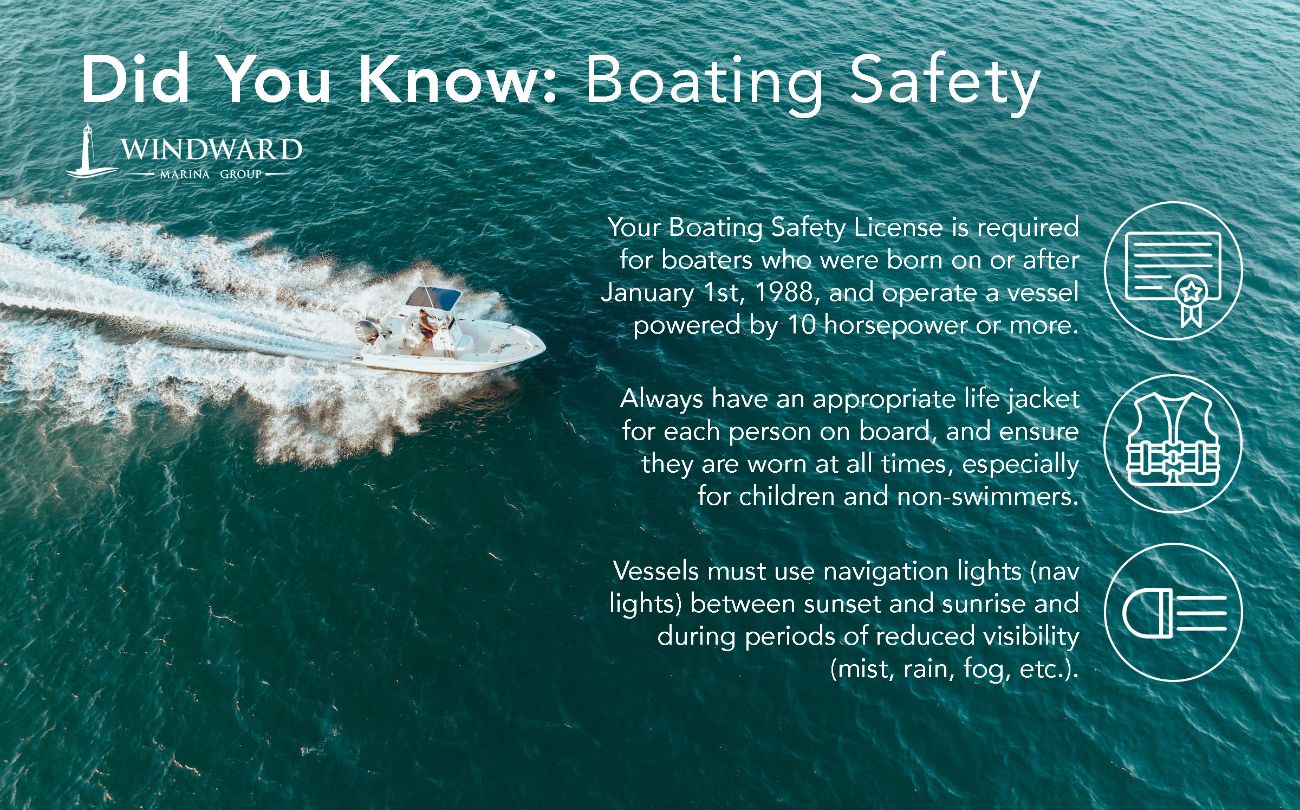
Boating Safety
Boating can be a truly exhilarating and relaxing experience. Whether you are out for a leisurely cruise or tackling the open sea. Like any recreational activity, boating comes with its own set of responsibilities and safety should always be a top priority. Precautions should be taken before every trip as well as keeping the required equipment onboard.
Why Boater Safety Matters:
Boating accidents can lead to injuries, fatalities, property damage, and environmental harm. The leading contributors to boating accidents are alcohol use, operator inattention, and hazardous waters. Falls overboard has been the leading cause of fatal accidents, with drowning as the leading cause of death. With the right knowledge and precautions, accidents can be prevented, ensuring a safe and enjoyable boating experience.
Essential Boater Safety Rules and regulations:
Regulations vary based on the boat size; below are the basic safety equipment and requirements.
- Take your Boating Safety Course: Your Boating Safety License is required for boaters who were born on or after January 1st, 1988, and operate a vessel powered by 10 horsepower or more. Whether you are a beginner or an experienced boater, a boating safety course can provide valuable information about navigation, rules of the water, and emergency procedures. The best way to get your Boaters Safety License is through taking the free course provided by BoatUS.
- Wear Life Jackets: Life jackets save lives. Always have an appropriate life jacket for each person on board, and ensure they are worn at all times, especially for children and non-swimmers. Be sure it is the appropriate life jacket for the activity (shown on the label printed on the inside) and is U.S. Coast Guard approved.
- Lights: Vessels must use navigation lights (nav lights) between sunset and sunrise and during periods of reduced visibility (mist, rain, fog, etc.). Nav light switches are located on the dashboard near the steering wheel.
- Oar or Anchor: Anchors must have at least 50 ft of rope, cable, or chain.
- Flashlight or Flares: You must have either a waterproof flashlight onboard or one of the three flare types (type A, B, or C). Flares are only required on the high sea and coastal waters, but it is advised to store onboard wherever you are boating in case of an emergency. Boaters must carry a visual distress signal for both day and night use.
- Sound Signaling Device: Vessels less than 39.4 ft in length must carry an efficient sound-producing device like a bell, whistle, or air horn.
- Fire Extinguisher: One USCG-approved B-1 type is required for boats with inboard motors, fixed fuel tanks, and/or any fuel burning, cooking, heating, or refrigeration units. Outboard-powered vessels less than 26 ft long are excepted if vessel is constructed in a manner where gas fumes will not accumulate. Nonmotorized vessels are exempted from fire extinguisher requirements. These should be placed in a readily accessible location i.e., near the steering, in the galley, or in the engine room.
- Bailer or Handpump: Keeping a bailer or handpump onboard can reduce the chances of sinking while dealing with unwanted water in the vessel.
- Buoyant Heaving Line: The buoyant heaving line must be at least 50 ft in length.
Additional precautions to keep in mind while boating:
- Check The Weather: Be vigilant about weather conditions. Sudden storms can be dangerous, so check the forecast before heading out and keep an eye on the sky while on the water. Always have a plan for seeking shelter if severe weather strikes. Have a radio onboard to receive updates or weather warnings.
- Fuel: Check fuel levels before launching vessel. Use the rules of three: 1/3 to go, 1/3 to return, 1/3 reserve.
- Plan: Plan your boating trip before you leave. Let someone on land know your boating plans, including your intended route and expected return time. This way, if you do not return as planned, someone can alert the authorities.
- First-Aid Kit: Packing a first-ad kit will keep you prepared in the event of injuries.
- Charts and Tides: Be aware of local hazards, water levels, and tides. Check charts while boating to prevent accidents. Keep a compass onboard as well.
- Tools and Spares: Keep basic tools for your vessel onboard. Include spare items such as fuel filters, light bulbs, spark plugs, etc.
- Boat Maintenance/Upkeep: Be sure your vessel is receiving monthly and annual servicing like 50/100 hour for outboards, checking of oil levels and battery charge. While keeping up with regular maintenance of your vessel, check for additional things like cracks, hose leaks, operational nav lights, etc.
- Food and Clothes: Bring spare clothing in case the weather takes a turn for the worse. Pack drinking water and snacks.
Boating can be a wonderful and rewarding experience, but it should always be enjoyed responsibly. By prioritizing boater safety, you can protect yourself, your passengers, and the environment while ensuring a lifetime of enjoyable boating adventure. Remember, the key to safe boating is knowledge, preparation, and vigilance. Before you go out, make sure you are well-versed in boater safety best practices, and always keep safety at the forefront of your mind when on the water.



